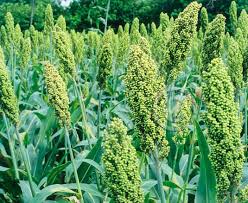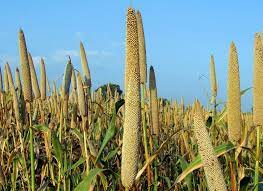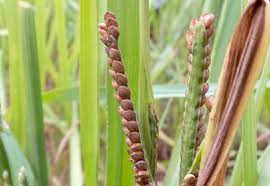Millets- Cultivation, Production & Nutrition
Introduction
- Millets are small-grained, annual, warm-weather cereal crops belonging to the grass family, widely grown around the world for human food and animal fodder.
- They are highly tolerant of drought and other extreme weather conditions and possess a similar nutrient content to other major cereals.
- Millets are important crops in the semiarid tropics of Asia and Africa continent and accounting 97% of production in developing countries. Due to short growing period, good productivity under dry, high-temperature conditions, millets are considered favourite crops in these conditions.
- The most widely grown millets are sorghum (Jowar) and pearl millets (Bajra), which are important crops in India and parts of Africa. Finger millet, proso millet, and foxtail millet are also important crop species.
- Millets are members of the family Poaceae (the grasses).
- Millets are also termed as Nutricereals.
- Upon request by Indian Government in 2018, the Food and Agriculture Organisation of the United Nations (FAO) declared 2023 as International Year of Millets.
- The most commonly Cultivated millets are:
Genus: Eleusine
Eleusine coracana: Finger millet (also known as ragi in Hindi, kodo in Nepal).
Genus Panicum:
- Pennisetum glaucum: Pearl millet (known as Bajra in Hindi, also known as sajjey in Kannada and ‘Kambu’ in Tamil).
- Panicum miliaceum: Proso millet (common millet, broomcorn millet, hog millet, or white millet, also known as baragu in Kannada, panivaragu in Tamil).
- Panicum sumatrense: Little millet (also known as Saamey in Kannada, Samalu in Telugu and Sāmai in Tamil).
- Panicum sonorum: Sonoran millet (cultivated in Southwest America).
- Setaria italica: Foxtail millet, Italian millet, panic (also known as navaney in Kannada and ‘thinai’ in Tamil)
Genus Echinochloa: Also called barnyard grasses or barnyard millets; other common names are Jhangora, Samo seeds or Morio / Mario seeds.
- Sorghum bicolor: Sorghum; sometimes known as great millet.
- Echinochloa frumentacea: Indian barnyard millet, also known as Sawa millet.
- Echinochloa esculenta: Japanese barnyard millet.
- Echinochloa oryzoides
- Echinochloa stagnina: Burgu millet.
- Echinochloa crus-galli: Common barnyard grass (or Cockspur grass).
- Paspalum scrobiculatum: Kodo millet.
- Brachiaria deflexa: Guinea millet.
- Brachiaria ramosa: Browntop millet.
- Spodiopogon formosanus: Taiwan oil millet, endemic to Taiwan.



History of Domestication of millets in the Indian Subcontinent
- Little millet (Panicum sumatrense) is believed to have been domesticated around 5000 before present and Kodo millet (Paspalum scrobiculatum) around 3700 before present in Indian subcontinent.
- Yajurveda (Indian Veda) also describes foxtail millet (priyaṅgu), Barnyard millet (aṇu) and black finger millet (śyāmāka), indicating that millet cultivation was happening around 1200 BCE in India.
Research Centre
- International Crops Research Institute for the Semi-Arid Tropics (ICRISAT) and ICAR-Indian Institute of Millets Research in Telangana, India.
- ICAR- All India Coordinated Millet Improvement project (AICMIP) was established in 1965, HQ- IARI New Delhi. But HQ was shifted to Jodhpur, Rajasthan in 1995.
Millets Cultivation
- Millets are more reliable than most other grain crops under the conditions of poor, dry infertile soils. Hence, Pearl millets is one of the major crops in the semiarid, poor, less fertile agriculture regions of Africa and southeast Asia.
- ‘Okashana 1’, variety developed in India from a natural-growing millet variety in Burkina Faso, doubled yields. it was released in 1990 in Namibia and became the most popular variety there.
Millets Production
In 2020, global production of millet was 30.5 million tonnes. India ranked 1st with 41% of the world total.
Top millets producing countries (2020), (source: FAO)
- India: 12.5 million tonnes (MT)
- Niger: 3.5 MT
- China: 2.3 MT
- Nigeria: 2.0 MT
- Mali: 1.9 MT
- Ethiopia: 1.2 MT
Usage
- Food source: Millets are major food sources in arid and semiarid regions of the world. In western India, sorghum (Jowar) has been commonly used with millet flour to make the local staple, hand-rolled, flat bread (rotla in Gujarati, bhakri in Marathi, or roti in other languages). Ragi (finger millet) with the popular ragi rotti and Ragi mudde is a popular meal in Karnataka.
- Millets are highly nutritious, non-glutinous and non-acid forming foods. People affected by gluten-related disorders, and wheat allergy sufferers, who need a gluten-free diet, can replace gluten-containing cereals in their diets with millet.
- Common ingredient in seeded bread and are also used as bird and animal feed.
- Alcoholic beverages: Various alcoholic beverages are produced from millets in India. Millet is also the base ingredient for the distilled liquor rakshi.
- Grazing millet: Instead of letting the plant reach maturity, it can be grazed by stock and is commonly used for sheep and cattle. Since, millet is a C4 plant, it has good water-use efficiency and utilizes high temperature and is therefore a summer crop. Millet grows rapidly and can be grazed 5–7 weeks after sowing, when it is 20–30 cm high. The Japanese millets (Echinochloa esculenta) are considered the best for grazing.
Nutritional Value
Generally, millets on an average contains 12% protein, 2-5% fats, 65-75% carbohydrates, and 15-20% dietary fibres.
Panicum miliaceum (Nutritional value per 100 g)
Energy 1,582 kJ (378 kcal) Carbohydrate 72.8 g Dietary fibre 8.5 g Fats 4.3 g Proteins 11.0 g Vitamins Riboflavin (B2) 0.29 mg Niacin (B3) 4.72 mg Pantothenic acid (B5) 0.85 mg Vitamin B6 0.38 mg Folate (B9) 85 μg Vitamin C 1.6 mg Vitamin K 0.9 μg Minerals Calcium 8 mg Iron 3.0 mg Magnesium 114 mg Manganese 1.6 mg Phosphorus 285 mg Potassium 195 mg Sodium 5 mg Zinc 1.7 mg Other constituents Water 8.7 g Copper 0.8 mg Selenium 2.7 µg
Health Benefits of Millets
- Millets are anti acidic.
- Millets are gluten free.
- Millets detoxify body.
- Niacin in millets can help lower cholesterol.
- Prevent breast cancer.
- Helps to prevent Type2 diabetes.
- Effecting in reducing blood pressure.
- Helps to protect against heart disease.
- Aids in treating respiratory conditions such as Asthma.
- Helps to optimize kidney, liver and immune system health.
- Reduces risk of gastrointestinal conditions like gastric ulcer or colon cancer.
- Eliminates problems like constipation, excess gas, bloating and cramping.
- Acts as a prebiotic feeding microflora in your ecosystem.
See also….
Millets One Linear Notes